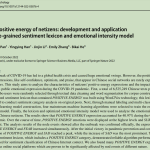
分享一篇最近发表的文章
The positive energy of netizens: development and application of fine-grained sentiment lexicon and emotional intensity model
The outbreak of COVID-19 has led to a global health crisis and caused huge emotional swings. However, the positive emotional expressions, like self-confidence, optimism, and praise, that appear in Chinese social networks are rarely explored by researchers. This study aims to analyze the characteristics of netizens' positive energy expressions and the impact of node events on public emotional expression during the COVID-19 pandemic. First, a total of 6,525,249 Chinese texts posted by Sina Weibo users were randomly selected through textual data cleaning and word segmentation for corpus construction. A fine-grained sentiment lexicon that contained POSITIVE ENERGY was built using Word2Vec technology; this lexicon was later used to conduct sentiment category analysis on original posts. Next, through manual labeling and multi-classification machine learning model construction, four mainstream machine learning algorithms were selected to train the emotional intensity model. Finally, the lexicon and optimized emotional intensity model were used to analyze the emotional expressions of Chinese netizens. The results show that POSITIVE ENERGY expression accounted for 40.97% during the COVID-19 pandemic. Over the course of time, POSITIVE ENERGY emotions were displayed at the highest levels and SURPRISES the lowest. The analysis results of the node events showed after the outbreak was confirmed officially, the expressions of POSITIVE ENERGY and FEAR increased simultaneously. After the initial victory in pandemic prevention and control, the expression of POSITIVE ENERGY and SAD reached a peak, while the increase of SAD was the most prominent. The fine-grained sentiment lexicon, which includes a POSITIVE ENERGY category, demonstrated reliable algorithm performance and can be used for sentiment classification of Chinese Internet context. We also found many POSITIVE ENERGY expressions in Chinese online social platforms which are proven to be significantly affected by nod events of different nature.
引用格式
Pan, W., Han, Y., Li, J. et al. The positive energy of netizens: development and application of fine-grained sentiment lexicon and emotional intensity model. Current Psychology 42, 27901–27918 (2023). Doi:10.1007/s12144-022-03876-4
作者信息
School of Public Administration, South China University of Technology, Guangzhou, China
Wenhao Pan & Yingying Han
School of Psychology, Guizhou Normal University, Guiyang, China
Jinjin Li
Department of Intelligent Engineering, Guiyang Institute of Information Science and Technology, Guiyang, China
Bikai He
原文链接:https://doi.org/10.1007/s12144-022-03876-4



第一,人生故事分享

第二,个人近况分享

第三,匿名故事分享

第四,计算机知识分享

第五,专业知识分享

第六,旅游知识分享

第N 。。。。。。。。。











 湘公网安备 43010202000590号
湘公网安备 43010202000590号